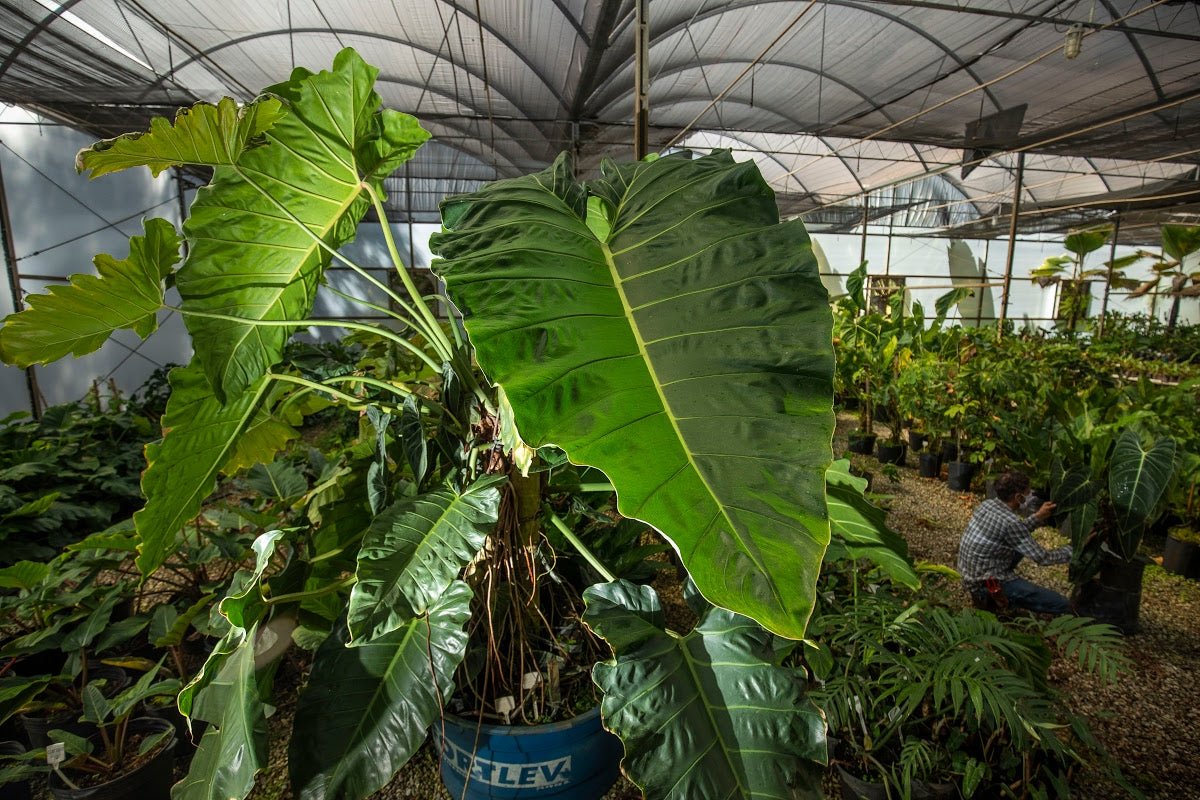With leaves that can stretch over 3 feet, Philodendron Maximum certainly lives up to its name, bringing an impressive, dramatic presence that any seasoned collector would be proud to showcase. This striking philodendron originates from the dense rainforests of Central and South America, thriving beneath a canopy of filtered light and high humidity. For collectors ready to take on a more advanced challenge, Philodendron Maximum offers immense rewards. Let’s explore its unique requirements and some expert tips for encouraging its growth.
Origins and Characteristics
Philodendron Maximum is known for its grandeur, boasting some of the largest leaves in the philodendron family. In its natural rainforest habitat, it grows under a dense canopy that filters light and maintains consistent humidity. It adapts well to low light but reaches its full potential with bright, indirect light. Its name, Maximum, is no exaggeration; this plant’s ability to develop massive leaves brings a tropical ambiance and mature, architectural quality to any plant collection.
Ideal Environment and Lighting
Replicating its rainforest habitat is key. Philodendron Maximum prefers medium to bright indirect light but is sensitive to direct sunlight, which can lead to leaf burn. Those with controlled lighting systems may find that gradually rotating the light source simulates the natural dappled light shifts it would experience outdoors, fostering even growth and preventing a leggy appearance.
Consider dedicating a consistent light source positioned to offer uniform coverage, especially in taller spaces. Maintaining such an environment can result in larger leaves and healthier, fuller growth.
Humidity and Watering
A humidity-loving species, Philodendron Maximum thrives in levels between 70-85%. This philodendron is also well-suited for collectors using beneficial mites for pest management, as the plant’s environmental needs align well with these naturally pest-resistant allies. Incorporating beneficial mites can prevent infestations from the start, keeping pests under control without disrupting the plant’s delicate ecosystem.
For watering, finding the balance between moisture and aeration is crucial. Its root system appreciates a well-draining soil mix but requires some moisture retention to support its expansive growth. An ideal mixture combines orchid bark, charcoal, and perlite to hold moisture without compacting the soil, allowing roots to breathe and flourish. Adjusting watering schedules seasonally can be an advanced strategy; in winter, slightly reducing water allows the plant to adapt to its natural growth cycle, enhancing its resilience.
Soil and Nutrients
Unlike many philodendrons, Philodendron Maximum benefits from a slightly richer soil mix, mimicking the natural humus-rich rainforest floor. Incorporating organic amendments, such as worm castings or decomposed leaf litter, provides a slow-release nutrient source that promotes robust growth.
Trace minerals are essential, particularly calcium and magnesium, which help prevent chlorosis and bolster leaf vitality. For the more advanced collector, adding mycorrhizal fungi to the soil fosters a symbiotic relationship with the roots, increasing nutrient absorption, root strength, and overall resilience. Fertilizing once a month with a diluted balanced fertilizer during the growing season also supports its impressive foliage.
Growth Patterns and Pruning
Philodendron Maximum has a naturally climbing growth pattern, which collectors can encourage with a moss pole or tree bark mount. The plant's aerial roots readily attach to supports, mirroring its natural growth on rainforest trees and promoting larger, fuller leaves. Regular misting of the moss pole or bark provides the moisture its aerial roots crave, fostering vigorous, healthy growth.
To encourage a bushier shape and manage its impressive size, occasional pruning is beneficial. Cutting above a node can stimulate new growth and prevent legginess, but it’s best to avoid over-pruning, as this philodendron can be slow to recover. Observing its response after each prune will help you find the right balance.
Pests and Disease Management
Philodendron Maximum is resilient but susceptible to pests like spider mites, thrips, and scale when humidity levels drop. Many advanced collectors find that beneficial mites offer a proactive solution, managing pests before they take hold and ensuring the plant’s ecosystem remains balanced. A monthly neem oil spray during the active growing season also acts as a preventative measure, forming a protective barrier on its leaves.
Due to the high humidity requirements, fungal infections can occasionally occur. A well-ventilated area with consistent air circulation minimizes this risk, and a light application of copper-based fungicide may be used as a preventive measure during high-risk seasons.
Advanced Tips
-
Water Quality: Philodendron Maximum responds best to distilled or filtered water, as it’s sensitive to the minerals in tap water. Avoiding mineral buildup helps maintain soil quality and ensures nutrient uptake.
-
Root Zone Heating: If conditions allow, consider mild bottom heating during colder months. This can maintain steady growth and support root health in environments where room temperature fluctuates.
-
Air Layering for Propagation: Air layering is an effective propagation technique, especially for collectors who wish to propagate without impacting the parent plant. It allows you to observe root development before fully separating the new plant.
-
Humidity Domes for Acclimation: During the initial acclimation period, especially after a recent acquisition or repotting, a humidity dome can create a stable environment for the plant. This temporary setup provides high humidity, easing its transition before adjusting to regular ambient conditions.
A Rewarding Challenge
Philodendron Maximum is a striking addition to any collection, offering advanced collectors the opportunity to cultivate a truly show-stopping philodendron. Its grandeur and unique needs make it a rewarding challenge, and with proper care, it can become the crown jewel in any plant collection.

